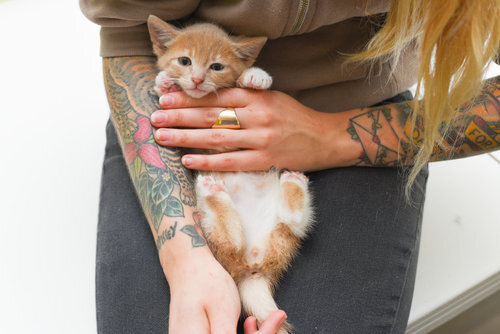Trimming your kitten’s claws can seem like a daunting task, but anyone can learn how to do it. Whether you’re a foster parent or a new adopter, knowing how to trim your kitten’s claws is an important skill to have!
Why Does a Kitten Need Claws?
The claws are an important part of a kitten’s body. During the first month of life, the claws are non-retractable, which may aid in kneading the mother to stimulate milk production. Around four weeks old, the kitten develops the ability to retract the claws into the paw. Kittens use their claws to scratch and groom themselves, to stretch, to balance, for self defense, and to explore their environments (just how human babies use their hands to explore). Most importantly, claws give cats the comfort and confidence to know that they can protect themselves and navigate the world around them safely.
Knowing how necessary the claws are, it should go without saying: never declaw a cat! Declawing is a cruel procedure that permanently mutilates the cat, and can result in unnecessary pain and discomfort, as well as emotional and behavioral issues. Instead of cruel tactics like declawing, help your kitten get used to regular nail trimming by starting to trim her claws at 4 weeks of age.
Watch Kitten lady’s
Claw Trimming video here:
How to Trim Kitten Claws
1. Get the Right Supplies
Trimming a kitten’s claws is just as easy as trimming your own nails, but you will need a special cat nail trimmer. You want to make sure that you are using cat nail trimmers and not a human nail trimmer, as using the wrong tool may result in an injury to the kitten.
2. Set the Mood
In order for both you and your kitten to have a pleasant experience, you’ll want to do the nail trimming in a low-stress environment. This is a new experience for the kitten, so you want to make it as comfortable as possible. Try trimming claws away from loud noises and distractions, maybe after a meal time or when the kitten is nice and sleepy!
3. ONLY Trim the White Part
When trimming your furry friend's nails you may notice that her nails are white on the ends and pink closer to their paw, just like human fingernails are pink with white tips. Only clip the white part of the kitten’s nail, just like you would only clip the white part of yours. The pink that you are seeing is actually their flesh, and cutting this part of the nail will cause your kitten a lot of unnecessary pain and bleeding. If you’re not sure how far down to cut, simply start by trimming just the very tip of the claw. It’s always better to cut too little than too much, so go slow!
4. Positive Reinforcement!
One wonderful thing about starting claw trimming young is that the kitten will get used to the sensation of having her paws touched. Be sure to make this a positive experience! After trimming your kittens nails, try giving her a favorite treat (maybe a meat tube!) as a reward for good behavior. By using positive reinforcement, you’ll ensure that trimming the kitten’s claws will continue to be a breeze as they get older.
Trimming Your Kitten’s Claws and Still Experiencing Unwanted Clawing?
If you are still experiencing unwanted scratching after trimming your kittens claws, there are many things you can do!
Get a scratching post for every room where your kitten regularly spends time, placing it near the item that is getting clawed. I recommend buying a sturdy, rectangular scratch post and putting it right next to your couch!
Observe the kitten’s scratching behavior. Some kittens prefer vertical scratching (ie: on the leg of a chair) while others prefer horizontal scratching (ie: on the arm of a chair.) Get your kitten scratching posts that match her preferred scratching style.
For people who frequently foster kittens, try a reusable cardboard scratcher you can change between litters.
Use couch corner protectors if the kitten is clawing your furniture.
Try using a pheromone calming spray.
Give your kitten lots of enrichment and appropriate play time. Always redirect clawing behaviors toward an appropriate target--for every “no,” be sure to offer your kitten an equal or better “yes!”
Keep in mind that when a cat scratches furniture, she’s actually sending you a very sweet message--that she is trying to create a family scent with you. By remembering why cats scratch, and accepting it as part of life with a feline friend, we can begin to appreciate this behavior and direct it in a way that helps keep everyone happy.
Scratching and biting are both natural behaviors, but there are always things that you can do to keep kittens from targeting your furniture and hands!





